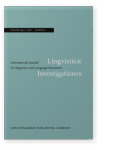Vol. 44:1 (2021) ► pp.66–100
Compounding in Old Italian
A constructionist analysis
This paper provides a corpus-based analysis of compounding in Old Italian. The semantic and formal properties of compound words attested in Old Italian are described and discussed through the theoretical tools provided by Construction Morphology. The analysis confirms that compounding is exploited since the earliest attestations of the language. It reveals that Old Italian compounds are mostly right-headed endocentric or exocentric: particularly, endocentric [ADV-Y]Y, [A-N]N|A and exocentric [V-N]N are the most productive schemas. Moreover, this study highlights a significant influence of Latin on Italian compounding, whereby many Old Italian compounds are Latin loanwords and calques which served as a model for the creation of new native compounds.
Article outline
- 1.Introduction
- 2.Theoretical framework and methodology
- 3.Analysis
- 3.1Left-headed endocentric Constructions comp in Old Italian
- 3.2Right-headed endocentric Constructions comp in Old Italian
- 3.3Coordinative endocentric Constructions comp in Old Italian
- 3.4Exocentric Constructions comp in Old Italian
- 4.Discussion
- 5.Conclusion
- Notes
- Abbreviations
-
References
